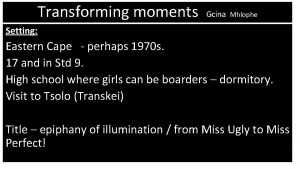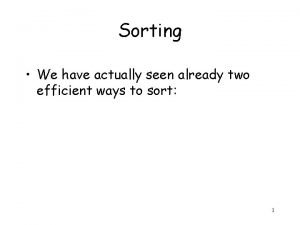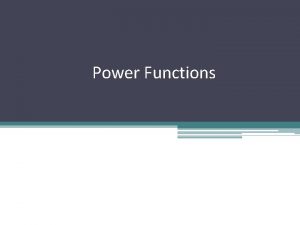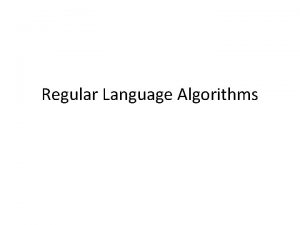Power Analysis n Many of you have seen
















- Slides: 16

Power Analysis n Many of you have seen OCC’s – First specify test size a, s 2, m in a CRD – Compute : – Compute

Power Analysis-Noncentrality parameter n Compute a summary measure of Ha: n OCC curves will depend on a, and the numerator and denominator df

Power Analysis—Using tables n Select the appropriate OCC curve f on horizontal axis intersects appropriate OCC n Read b on vertical axis; compute 1 -b n Find where vertical line drawn from

Power Analysis—Sample Size Analysis n OCC’s can be used for sample size analysis, but they are awkward n The curves are computed from the distribution of the F statistic under HA

Derivation of OCC’s n Recall that

Properties of Mean Squares n Regardless of the true state of nature, where

Non-centrality parameter n A non-central c 2 rv is often introduced as a sum of independent squared N(li, s 2) rv’s; its noncentrality parameter would be: n In our case, the normal components are not independent.

Non-central F n We say that F has a noncentral F distribution with noncentrality parameter d 2 n A non-central F rv is based on a ratio of independent non-central c 2 and central c 2 rv’s

Derivation of Power

Power formulas n For the balanced case, we have:

Computer Code n SAS example n R code S 02<-rep(seq(1, 5), each=14) n<-rep(seq(2, 15), 5) ncvec<-n*s 02

R Computer Code Power<-1 -pf(qf(. 95, a-1, n*a-a), a 1, n*a-a, ncvec) Contour(seq(2, 15), seq(1, 5), matrix (power, ncol=5), xlab=“Sample Size”, ylab=“Effect”)

Power Analysis for Contrasts n Magnitude of contrasts under HA is easy for experimenters to articulate (Yandell, Edwards) n We consider one df contrasts only (Yandell focuses on specific cases; our treatment will be more general)

Non-central F for contrasts n We will test Ho: L-Lo=0 vs. HA: L-Lo≠ 0 – Typically, Lo=0 n Regardless of the true state of nature,

Non-central F: balanced case n For the balanced case,

SAS code for contrasts n To adapt the SAS program to contrasts, note that the coefficient of n in the noncentrality parameter has changed – Loop on L (not s 02) and calculate the remaining terms in the noncentrality parameter in the loop – This ensures that L is output – Remember to change numerator df
 What is prufrock's problem
What is prufrock's problem Have you ever seen a greenhouse
Have you ever seen a greenhouse Have you seen this area before?
Have you seen this area before? My eyes have seen you lyrics
My eyes have seen you lyrics Iiintent
Iiintent What is a stanza in poetry
What is a stanza in poetry Have u ever seen a penguin come to tea
Have u ever seen a penguin come to tea The toilet by gcina mhlophe
The toilet by gcina mhlophe Reverse image search
Reverse image search Plural crocodile
Plural crocodile I may have seen you
I may have seen you You are not rejected
You are not rejected Power triangle diagram
Power triangle diagram Words have meaning and names have power
Words have meaning and names have power Does congress have the power to have no mail on saturdays
Does congress have the power to have no mail on saturdays What have they seen in your house
What have they seen in your house My eyes have seen the glory of the coming of the lord
My eyes have seen the glory of the coming of the lord































